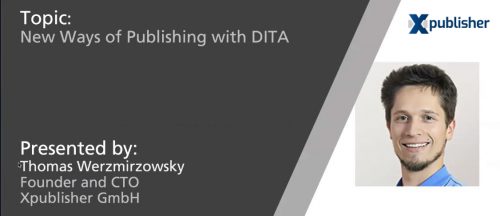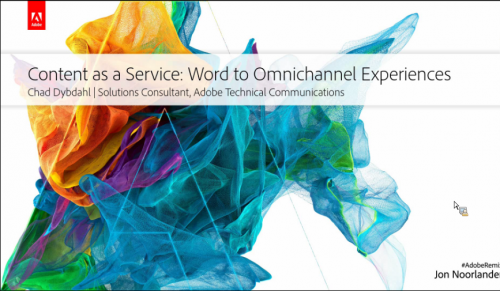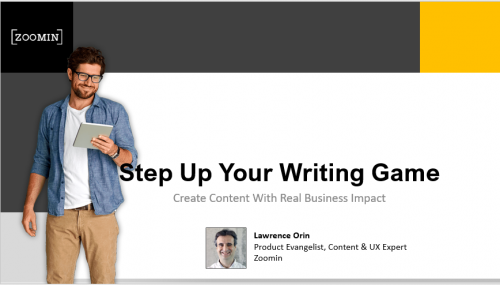- The definition of “information enablement”
- How your content is tied to your brand’s ability to grow exponentially
- How the 4th Industrial Revolution will impact global businesses, including yours
-
August 5, 2020 Abstract Business leaders around the globe are looking for ways to replicate the successes of innovative and disruptive organizations like Uber, Amazon, and Spotify that grow exponentially. Rather than adding 10%, they’re looking for 1000%. Exponential growth is deliberate and involves organizations developing capabilities that dramatically outperform the competition. Rob Hanna explores how information-enablement across the enterprise is key to this type of performance and why we need to rethink how we create content to become Exponential Organizations. What you’ll learn
-
February 5, 2020 If you are implementing a large-scale infrastructure project such as a cCMS implementation or migration to DITA at your organization, then you know about predictable costs such as purchasing hardware, licensing software, and training writers. Predictable expenses are easy to manage and plan for as you know when they will be due, and at least approximately how much they are going to cost. There are, however, other potential costs that may be unknown, either because your requirements have iterated since the original project scope was defined or you have uncovered something unexpected in your environment. These unpredictable expenses can add risk to the overall project timeline or impact the actual cost. They may be challenging to fit into your existing plan or require additional planning. In this webinar, Sabine Ocker will discuss some top hidden costs and provide insights on how to identify, plan for, and mitigate the impact of common examples such as changes to project scope, lack of appropriate standards, and content conversions. Presented by: Sabine Ocker has 20 plus years’ experience helping companies solve their interesting business problems. Solutions have included DITA migrations, content conversions, new tools or CMS, information modeling, content strategy, multi-channel publishing, and taxonomy development.
-
June 10, 2021 The Xpublisher editorial system organizes every piece of content – regardless of how it will be used later – to provide fast, error-free, and highly cost-effective multichannel digital and print publishing. Preparing your content for a variety of formats and channels couldn’t be easier. In this webinar, Thomas Werzmirzowsky will present new ways of DITA integration with Xpublisher. Xpublisher offers the best possible data quality with XML-based data management and is a pioneer for the challenges of the future by presenting new solutions: the simple creation, management, and publication with DITA. Presented by: Thomas Werzmirzowsky is founder and Chief Technology Officer at Xpublisher GmbH, a leading software provider specialized in the area of XML publishing. Since 2009, the company has been advising numerous leading international companies and organizations from the aerospace, technology, education, publishing, public administration and many other industries in the area of multichannel publishing and accompanying them on their way to digitization.
-
June 5, 2019 In today’s market, companies with service organizations are responsible for contributing 30%+ to overall company profit. While much of the effort in the last five years has gone into automating task management for Service Managers and technicians, a large gap remains in the way service organizations effectively find, use, and capture critical content specific to the task. Service Information Delivery solves the age-old struggle of providing accurate and relevant content to field service personnel as the task or job is being performed. It also captures and shares data during the process and provides audit trail and analytics upon completion. All critical functions to help the Service organization perform at the highest level within the business. Attendees will learn: 1. What is Service Information Delivery? 2. Why Service information delivery is critical in today’s business environment? 3. How can this impact the overall Service business and bottom line? Presented by: Stephanie Castillo is VP Business Operations – Titania Partnership, a leading provider of expert services and software. For more than 20 years Stephanie has been managing global documentation initiatives and writing teams for global organizations. Throughout her career she has architected solutions, managed global implementations, defined processes, and supervised requirements gathering and tools selection projects for multichannel content publishing systems as well as global translation management systems. Stephanie holds an MBA from Cardinal Stritch University, BA in communications from University of Wisconsin. In her free time she enjoys spending time with her daughter and husband, running and playing soccer.
-
February 5, 2019 Your technical content is a valuable yet hidden asset: It impacts every stage of your customer journey and forms a significant - and often, the largest - component of your overall web presence. Easy access to personalized content is therefore key to the overall digital and user experience for your customers. In this webinar we explore the role of taxonomy and metadata to deliver on the promise of role-based and personalized experiences, taking into account a variety of content types. Presented by: Joe Gelb has over twenty years of experience helping enterprises implement, maintain and capitalize on structured content. At Zoomin Software, he has spearheaded the development of advanced technology solutions for dynamic content delivery. Prior to founding Zoomin and Suite Solutions, Joe was the CTO at Live Linx, a leading provider of software and system integration services for technical product information, where he designed and implemented solutions for aerospace, defense, manufacturing and hi-tech companies. Joe holds a degree in Mechanical Engineering from Stevens Institute of Technology.
-
Recorded: February 23, 2022 Structured content provides numerous benefits for organizations with authoring, managing, and delivering information. Perhaps your organization has realized these benefits—but what’s next? A formal content classification system, or a taxonomy, provides a framework that supports search, filtering, classification, consistent terminology, and more. The combination of taxonomy and structured content opens up compelling possibilities for digital delivery. Add continuous updates and advancements in business data, and you can transform the customer experience—but you may feel a little exposed out on the leading edge of technology. Sarah and Chip will present and discuss emerging trends, techniques, and technology for your digital information initiatives. During the webinar you’ll learn:
- How do you select and manage a good taxonomy?
- Classifying content – human, machine, or a combination?
- Coordinating taxonomy terms across various teams and languages
- Taking advantage of Semantic AI
- Business drivers examining tagging quality vs. quantity
- Best practices and actions for you
-
February 12, 2020 Products are sold into markets that cross both country and language boundaries, so product documentation must be localized. Localizing documentation is made easier with DITA, a capable Component Content Management System (CCMS), and a Translation Management System (TMS). Even with these systems in place, you must always consider best practices and pitfalls. Jim will begin with an overview of the localization process, of how content flows across systems and organizations. In this context, we will discuss techniques and also wins and pitfalls in automating and streamlining the localization process. In this session, attendees will learn:
- About the localization process-what are the various roles and how does content flow
- About use cases and constraints-what is incremental localization and what is the relationship of localization to the product release lifecycle
- About release management and localization-what role can branching play in localization
- About localization tools-how do CCMS, TMS, and LSP relate in the localization process
- About recent developments in automation-how can the localization process be accelerated through automation and what are the wins and pitfalls of automation
-
March 3, 2021 This webinar is free. Agile development makes specific demands on documentation teams, whose content creators need to be nimble, describe features in a piece-meal fashion, and find ways to report on their content development progress. Structured content is ideally suited to these needs. But experience has shown that some teams find it hard to move fully to an Agile methodology, often using an uneasy mix of waterfall and Agile processes. Precision Content’s Keith Schengili-Roberts will talk about the current state of Agile and structured content, and also give an introduction to the Iterative and Incremental Development (IID) methodology, a recent Agile offshoot that works well for technical writing teams. If you are wondering about what the impacts are of working with Agile or are simply looking to optimize your DITA-based documentation processes, this presentation is for you! Presented by: Keith Schengili-Roberts is a Content Specialist and Information Architect at Precision Content. Keith is also an award-winning lecturer on Information Architecture at the University of Toronto’s Faculty of Information, and the Chair of the OASIS DITA Adoption Committee. He is also the writer behind the “DITAWriter.com” website, which has long been a useful resource for those working with the DITA XML standard. He lives in the north end of Toronto with his long-time girlfriend Dhan and her two noisy green-cheeked conures.
-
Date: August 12, 2020 Squatches, yeti, and kraken: oh, my! Learn about cryptozoology, cryptids, and… oh yes: the future of content strategy and digital experiences. Chad Dybdahl, Adobe Solutions Consultant, walks you through importing content from Microsoft Word, creating intelligent, structured content that can then be used across a wide range of delivery channels and platforms. In this session, we’ll see both traditional and headless delivery strategies that will inspire you to think about content in new and exciting ways.
- Strategies to repurpose your technical content in new ways
- Headless content delivery: what is it and why you need it
- Creating structure from (MS Word) chaos
-
June 10, 2020 Abstract World has seen a very different modus operandi in the last couple of months. This only emphasizes the fact that collaborating without physically being in the same space is fast becoming the norm where team members are either located in different geographical locations or are working from home. At this time, a smooth review and collaboration process for technical content can be a real boon to your organization. In this session, Ayush Gupta, Product Manager at Adobe, will discuss how organizations can transform their mundane, time consuming and cyclic review process into a more meaningful, error-free and productive collaboration experience for Content Creators and Subject Matter Experts (SMEs). Key takeaways:
- Why rethink about current review processes
- What are the benefits of adopting online review process for DITA content
- What are the basic tenets and features of an online review process
- A walkthrough of a typical collaborative review workflow and how to make it an experience for business users
-
June 3, 2020 In these difficult times, it’s absolutely critical to demonstrate your value to your organization. As a technical communicator, your mission is to make sure you’re getting the right information to the right people. Part of the solution is to find the right tools – but they will only take you so far. Good content is crucial. You must write content in a way that best suits your audience and best matches their search patterns, so they can organically surface the information they need. Join Lawrence Orin, Product Evangelist and Customer Implementation Expert at Zoomin, as he takes an intriguing look at content strategy, and reveals a down-to-earth, practical approach that will ensure your writing is making a visible impact on your company. In it this webinar, you’ll learn:
- Practical steps to improving your writing skills
- Best practices for structuring content
- How to tailor your writing to your audience
-
March 6, 2019 In a world where Google sets the gold standard for providing relevant search results, how can technical documentation teams create findability that is always spot-on for every single reader? Relevance of search is determined by a combination of content metadata, contextual knowledge about the user, and the search query itself. The challenge therefore resides in collecting and analyzing these elements, and applying them systematically to every search query to create truly personalized search results. Presented by: Fabrice Lacroix is a known Web pioneer and the founder of Antidot, the company that puts enterprise content to work. As an entrepreneur, he has been working for 25 years on the development of the Internet and of the Web through several major companies.












